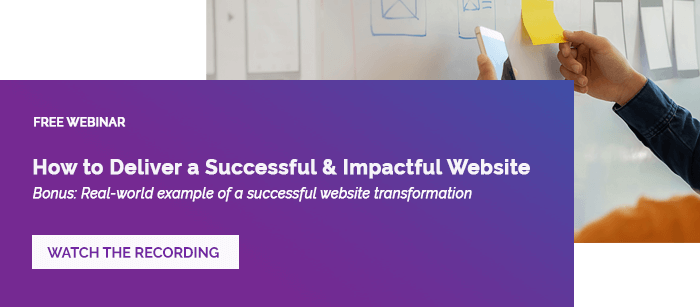The term "enterprise web design" refers to the process of creating and managing websites specifically for large-scale businesses and organisations. These websites must not only embody the company's brand and ethos but also cater to a broad and diverse audience ranging from stakeholders to the general public.
One of the critical elements of successful enterprise web development is understanding that these websites serve as a dynamic interface between the organisation and its audience. They need to be more than just informational repositories; they must act as digital experience platforms for interaction, transaction, and engagement.
In this context, building an enterprise website isn't just about creating a digital space but about crafting an experience that resonates with the users while advancing the organisation's goals.
As we delve deeper into the realm of enterprise website design, it's essential to recognise the must-haves of an effective enterprise website. From adhering to the principles of enterprise website design strategy to ensuring the clarity and purpose of messaging, the road to creating an impactful enterprise website is multifaceted and demands a strategic approach.
The Importance of Effective Web Design
The significance of effective enterprise web design in today's business environment cannot be understated. In a world where digital presence is often the first point of contact between a company and its potential customers, a well-designed website becomes a critical business tool.
What is enterprise web design? It goes beyond the visual appeal; it is a strategic blend of aesthetics, functionality, and user experience, tailored to meet the unique needs of large-scale businesses.
Enterprise web design is pivotal in establishing brand identity and trust
According to Stanford University, 75% of users judge a company's credibility based on its website design. In the realm of enterprise businesses, where competition is fierce, a website that reflects professionalism and attention to detail can significantly influence digital customer experience perception, and more importantly its impact on your business.
Effective enterprise web design is crucial for user engagement and retention
A website that is intuitive, easy to navigate, and responsive keeps users engaged, reducing bounce rates and increasing the likelihood of return visits. With an average attention span of about 8 seconds, users quickly move on if a website fails to capture their interest immediately.
Thus, successful enterprise web development hinges on creating an engaging user experience that captivates and retains visitors.
Its impact on SEO and online visibility
A well-designed website, optimised for search engines, enhances the company’s online presence, making it more discoverable to potential clients.
In fact, according to a survey by HubSpot, 61% of marketers state improving SEO and growing their organic presence is their top inbound marketing priority and 86% of consumers say search engines are the best way to get information, with people overwhelmingly using search engines to get answers online across all generations.
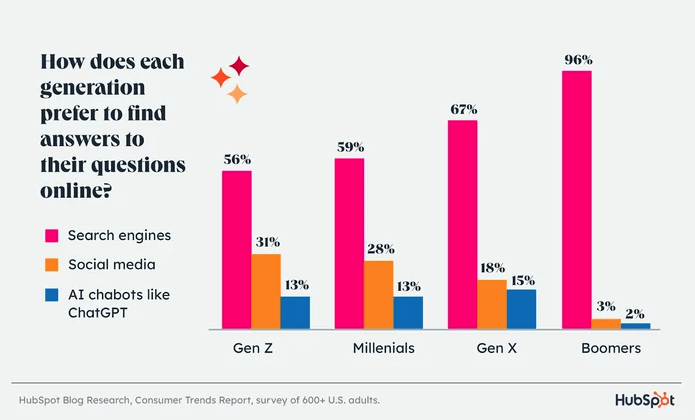
The responsiveness of a website is non-negotiable
According to the Google Mobile Movement Study, with over 50% of global website traffic coming from mobile devices, responsive design is no longer optional.
Google's mobile-first indexing means that a website's compatibility with mobile devices directly affects its search engine rankings. Responsive design ensures that the website provides a seamless experience across all devices, a must-have for enterprises aiming to reach a broader audience.
In essence, effective enterprise web design is not just about creating a visually appealing website. It's about constructing a strategic asset that enhances brand identity, engages users, improves online visibility, and adapts to the ever-changing digital landscape.

Principles of Effective Enterprise Web Design
Effective enterprise web design is a multifaceted discipline that requires a balance of aesthetics, functionality, and user experience.
Focusing on these principles enables enterprises to create websites that not only look great but also perform effectively, meeting the diverse needs of their users and advancing their business objectives.
Clarity and Purpose of Messaging
One of the cornerstones of effective enterprise web design is the clarity and purpose of messaging. A clear, concise message that aligns with the brand's values and objectives is vital. Every element on the website, from the header to the call-to-action buttons, should communicate this message effectively. This clarity not only helps in building brand recognition but also ensures that visitors understand the company’s offerings quickly, an essential factor considering the limited attention span of online users.
User-centred Design
User-centred design is fundamental in enterprise web design. This approach involves designing a website with the end-user's needs and experiences at the forefront. It means creating a logical, intuitive navigation structure that allows users to find information effortlessly. Incorporating elements like user feedback mechanisms and customisation options can significantly enhance the user experience, making the website more interactive and user-friendly.
Visual Appeal and Professionalism
The visual appeal of a website is crucial in creating a first impression. A well-designed website should be aesthetically pleasing and reflect the company's professional standards. This includes having a clear hierarchy, balanced proximity of elements, contrast to highlight key sections, a harmonious colour scheme, high-quality images, and a clean layout. A visually appealing website not only attracts users but also contributes to building trust and credibility.
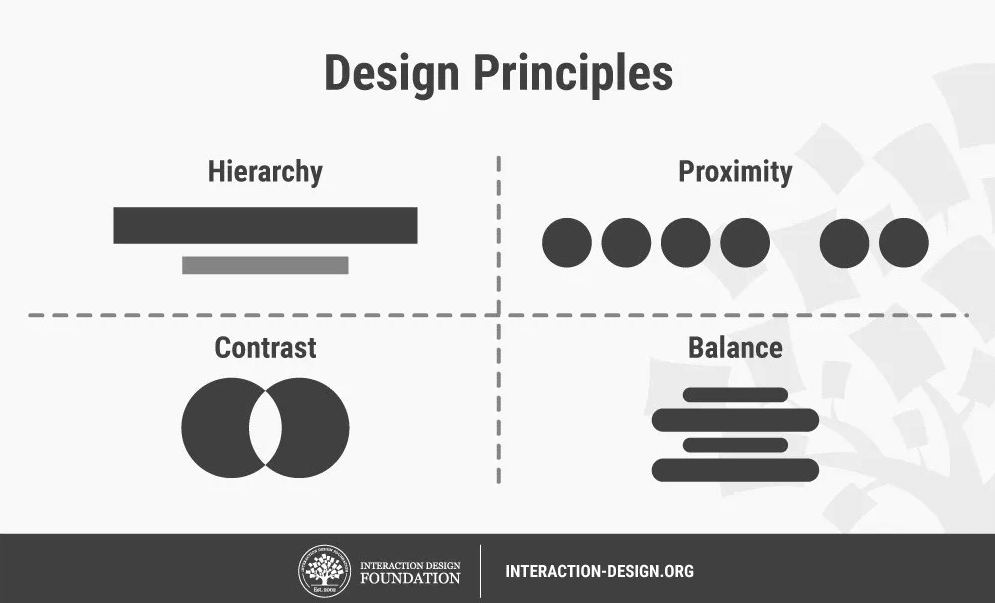
Source: Interaction Design Foundation
Responsive Design
With the increasing use of smartphones and tablets, responsive design has moved beyond being a website trend and has become a necessity. A responsive website automatically adjusts its layout to fit the screen size of the device it's being viewed on, providing an optimal viewing experience. This adaptability is crucial for reaching a wider audience and improving user engagement, as well as for SEO purposes.
Accessibility
Accessibility in web design ensures that the website is usable by people of all abilities and disabilities. This includes designing for various assistive technologies and adhering to standards like the Web Content Accessibility Guidelines (WCAG).
Making a website accessible not only broadens the audience but also demonstrates social responsibility and inclusiveness, important aspects for any enterprise.
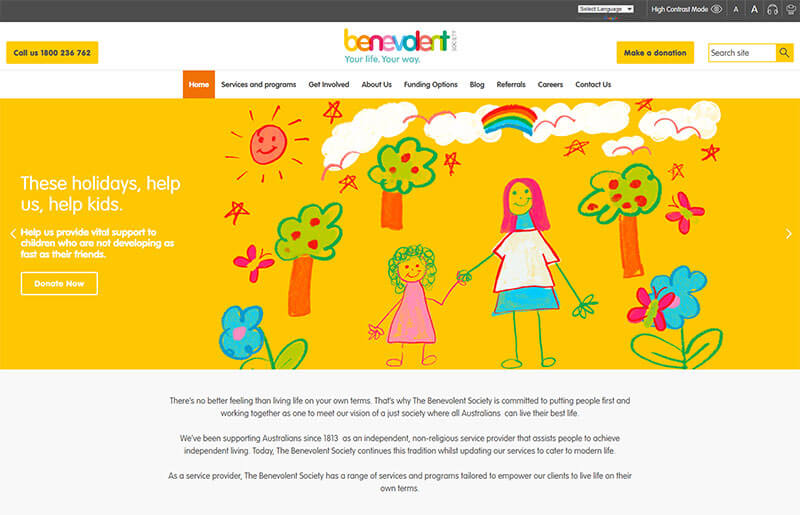
The Benevolent Society website, for example, features several functions that assist with accessibility including a high contrast mode, the ability to increase or decrease the size of text and the ability to have the content on their pages spoken to them. For more insights, check out The Benevolent Society case study.
6 Strategies for Crafting a Winning Enterprise Website
Lets dive into the essential website redesign strategies of successful enterprise web development, with a focus on practical advice and insightful tips to elevate your online presence.
1. Thorough Understanding of User Personas
This strategy involves meticulously researching and defining the various segments of your target audience - their needs, preferences, pain points, and online behaviours. By developing detailed user personas, you can tailor your enterprise website design to cater specifically to these groups.
The practical application of this knowledge lies in customising the website's content, design, and features to align with the expectations of each persona. For instance, a B2B company might focus on showcasing industry expertise and offering downloadable resources, while a B2C enterprise could prioritise showcasing products and user reviews. This approach not only improves user engagement but also increases the likelihood of conversion.
When building user personas, consider conducting surveys, analysing website analytics, and gathering feedback from existing customers. This data will provide invaluable insights into what your audience values most in a website, guiding your design and content strategies. Remember, a website that resonates with its users is one that turns visitors into loyal customers.
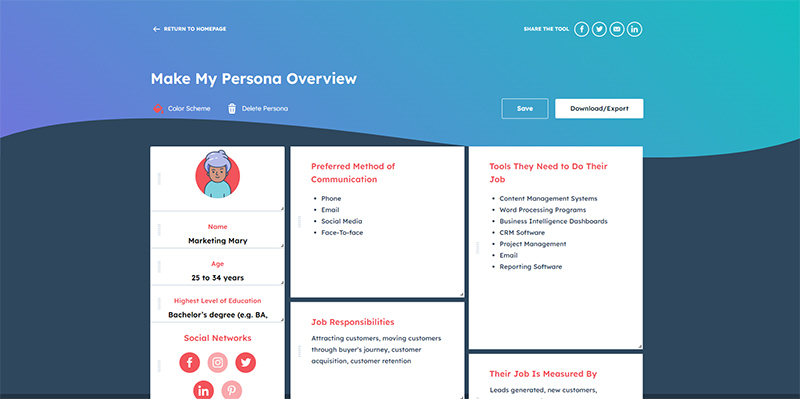
Now sure where to start? Hubspot have a free buyer persona tool that helps you build up and visualise your personas.
2. Intuitive Navigation and User Flow
Intuitive navigation and user flow are vital to ensure a seamless and efficient experience for visitors to your enterprise website. This strategy is about structuring your website in a logical, user-friendly manner that allows visitors to find information quickly and easily.
To achieve this, start by mapping out a clear hierarchy of your website's content. Organise information in a logical flow, with the most important pages being the most accessible. Utilise menus and sub-menus effectively, keeping them simple and avoiding over-cluttering. Dropdown menus can be helpful for websites with extensive content, but they should be used sparingly to avoid overwhelming the user.
Another aspect to consider is information scent. As Nielsen Norman Group explain, 'As the user considers whether to click on that link, the link label, the content that accompanies the link, the context in which the link appears, and any background knowledge (including recommendations from others) that the user may have about the source all influence the information scent that that source emits and thus the likelihood that the page will be visited or ignored.'
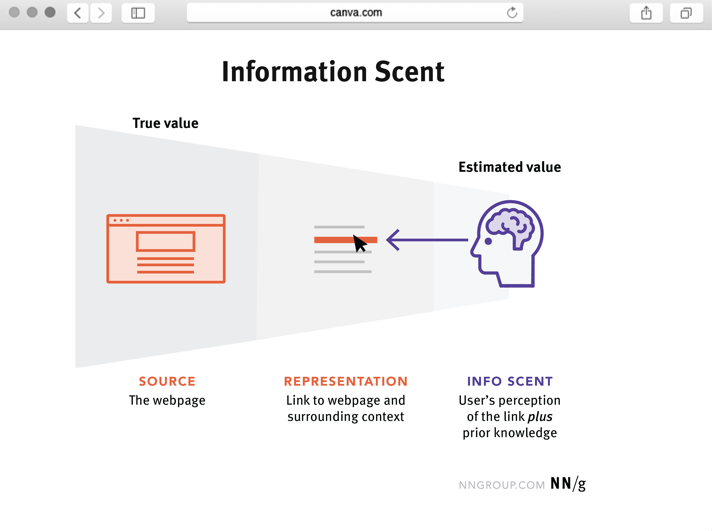
Source: NNG
Also, include a search function, particularly for content-rich websites. This feature allows users to quickly find specific information, enhancing the overall user experience. Regularly test your website’s navigation with real users to identify and fix any pain points, ensuring a smooth and intuitive journey through your website.
3. High-Quality Visuals
The use of high-quality visuals is a critical element in creating an engaging and professional enterprise website. Visuals, when used effectively, can communicate your brand's message more powerfully than text alone.
Start by choosing a color scheme that reflects your brand identity and resonates with your audience. Colors have the power to evoke emotions and create a visual connection with users. Consistency in color usage across the website strengthens brand recognition.
Incorporate high-resolution images that are relevant to your content. Professional photographs of your products, services, or team can significantly enhance credibility and user trust. In addition to static images, consider using videos or animations to explain complex concepts or showcase products in action.
Furthermore, the layout and spacing of visual elements play a crucial role in the overall design. Ensure that your website has a clean, uncluttered layout, with adequate white space to improve readability and focus on key elements.
Remember, visuals should complement the content, not distract from it. They should be optimised for fast loading times and be responsive, ensuring they display well on all devices. By investing in high-quality visuals, you create a visually appealing and memorable experience for your website visitors.
4. Engaging Content
Engaging content is the lifeblood of any enterprise website. It's not just about what you say, but how you say it. Your content should not only inform but also resonate and engage with your audience. It's crucial to understand the interests and pain points of your user personas and craft content that addresses these directly to improve customer engagement.
Start by developing a content strategy that outlines the key messages and tone of voice that align with your brand identity. Your content should be informative, relevant, and add value to your audience. This could be in the form of insightful blog posts, detailed case studies, informative videos, or engaging infographics. Each piece of content should serve a purpose, whether it's to educate, persuade, or entertain.
SEO is also a critical aspect of content creation. Use relevant keywords naturally within your content to improve search engine rankings, but avoid keyword stuffing. Keep your content fresh and updated regularly, as this not only helps with SEO but also encourages repeat visits. Don't be afraid to start using ChatGPT to assist you with everything from keyword research to content creation.
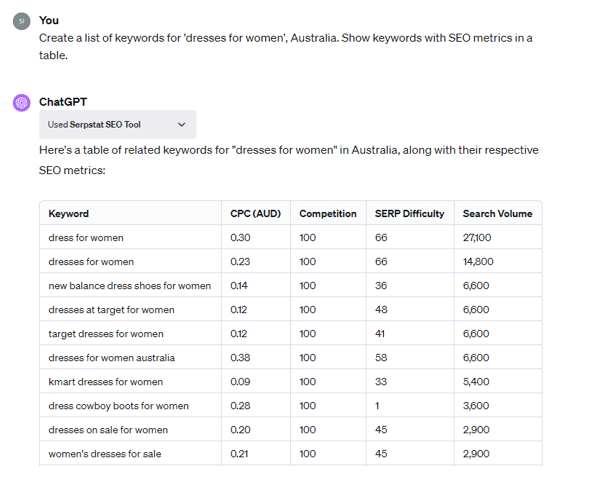
Additionally, ensure your content is accessible and easy to read. Break down complex ideas into digestible pieces, use headings and bullet points for easy scanning, and keep your language clear and concise. Engaging content is a powerful tool in building a connection with your audience and establishing your enterprise as a thought leader in your industry.
5. Optimising Website Performance
Optimising website performance is essential for providing a smooth and enjoyable user experience. A well-performing website not only retains visitors but also positively impacts your search engine ranking. Key aspects to focus on include loading speed, mobile responsiveness, and overall website stability.
Start by ensuring your website loads quickly. According to a study by Google, as page load time goes from one to five seconds, the probability of bounce increases by 90%. Optimize images, leverage browser caching, and minify CSS and JavaScript files to improve loading times. Regularly test your website's speed using tools like Google PageSpeed Insights for insights and recommendations.
Mobile responsiveness is another crucial aspect. With an increasing number of users accessing websites via smartphones, your website must provide a seamless experience across all devices. This means having a responsive design that adjusts to different screen sizes and orientations.
Finally, ensure your website is stable and secure. Regularly update your CMS, plugins, and themes to the latest versions to prevent security vulnerabilities. Implement SSL certificates for secure data transmission, especially if you're handling sensitive user information.
By focusing on these key performance areas, you can ensure your enterprise website is fast, responsive, and reliable, delivering a superior experience to all users.
6. Clear Calls to Action
Clear calls to action (CTAs) are crucial for guiding users towards your desired outcome, whether it's making a purchase, signing up for a newsletter, or contacting your team. Effective CTAs are concise, compelling, and strategically placed to draw attention and encourage action.
To create effective CTAs, start by defining what action you want users to take on each page. Your CTAs should stand out visually, so consider using contrasting colors or design elements to make them pop. The language used in your CTAs should be action-oriented and create a sense of urgency or benefit. Phrases like "Start Your Free Trial Now" or "Download Our Free Guide" are more compelling than generic terms like "Click Here".
Placement is also key. Position your CTAs in high-visibility areas, such as above the fold (the part of the webpage visible without scrolling) or at strategic points in your content where users are most likely to make a decision.
Lastly, ensure your CTAs lead to a straightforward and frictionless experience. Whether it's a simple sign-up form or a multi-step checkout process, the journey should be easy and intuitive. By crafting clear and compelling CTAs, you can significantly increase your website's conversion rates, turning visitors into leads and customers.
Inner West Council
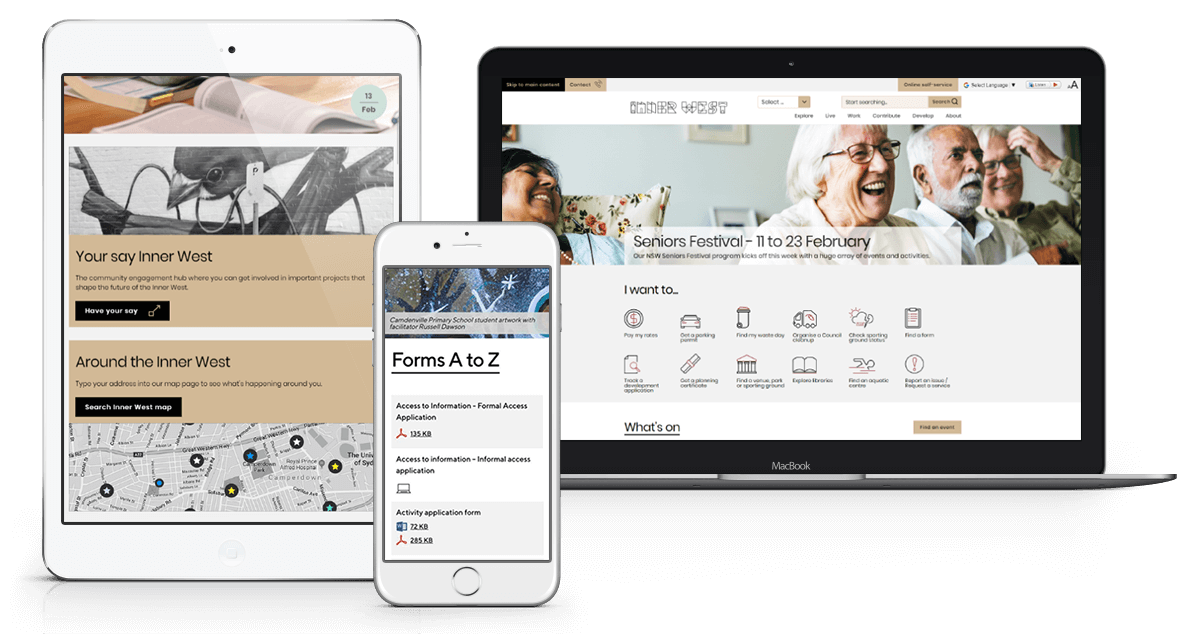
This website design example uses several of the tips we mentioned earlier.
The Inner West Council is a local government area in Sydney with a population of over 180,000 people. The council is an amalgamation of Ashfield, Leichhardt and Marrickville councils, who each managed their own websites, each using a different CMS. There was a need to align services and web-based offerings for residents, community members, businesses and other audiences.
A key part of getting this right was understanding user needs. The team sent out an email survey and meeting with 20-25 groups from across the council to collect feedback on the current websites and create a wish list for the new website. They then ran user groups with community members from different age ranges to gather further insights.
The solution was a new website that managed to convey vast amounts of information in a non-cluttered and user-friendly way.
A few things they did:
- Grouped information by themes so people can easily find related information in one place within a mega menu structure. For example, in the environments section, you would be presented with only news, events and projects related to this theme.
- The navigation menu is split by 3 key audiences ‘Explore’ for people who want to visit the area, ‘Live’ for those who are residents and ‘Work’ for those who work in the area.
- Quick links of the top 12 tasks performed on the website.
- And finally, they made the website as visual as possible so information is more easily consumed.
The What’s On page, for example, makes it easy to showcase all their events visually. People can filter events by date, category, location and more. Community members simply post their own events through an online form, which is then approved or rejected by their digital team.
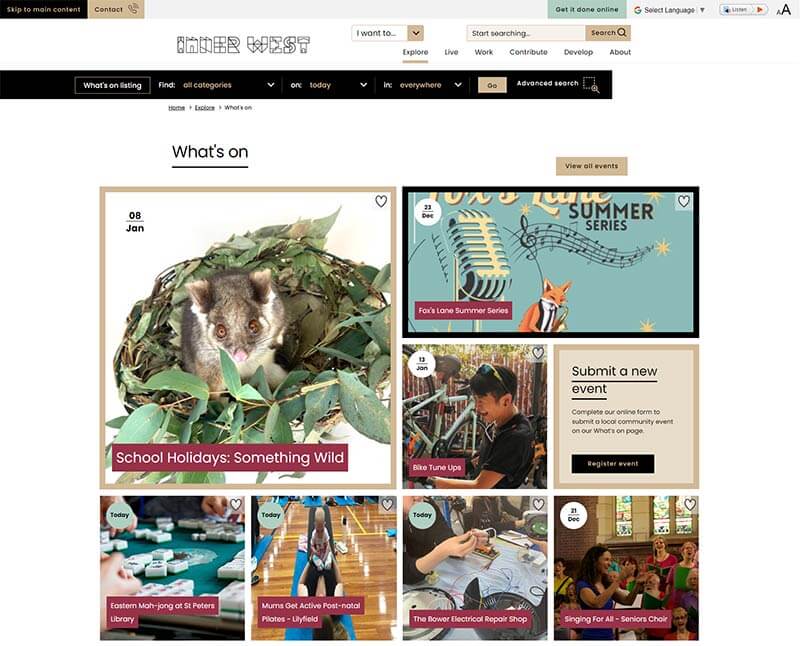
Conclusion
Crafting a successful enterprise website is a multifaceted process that requires a strategic blend of user understanding, intuitive design, compelling content, and technical excellence. Each of these six strategies plays a vital role in creating an effective enterprise web design that not only represents your brand but also engages and converts your target audience.
Embracing these strategies in your enterprise website design strategy will ensure that your site is not only visually appealing but also functional, relevant, and user-friendly.
Need more guidance? Check out the Website Redesign Playbook which contains both a guide and a comprehensive spreadsheet to help you get started on a redesign.
We have also hosted a webinar on 'How to Deliver a Successful and Impactful Website'. Whether you’re looking to redesign or optimise your website, these actionable insights will help ensure your website remains engaging and relevant for audiences, while being easy to maintain and manage.
